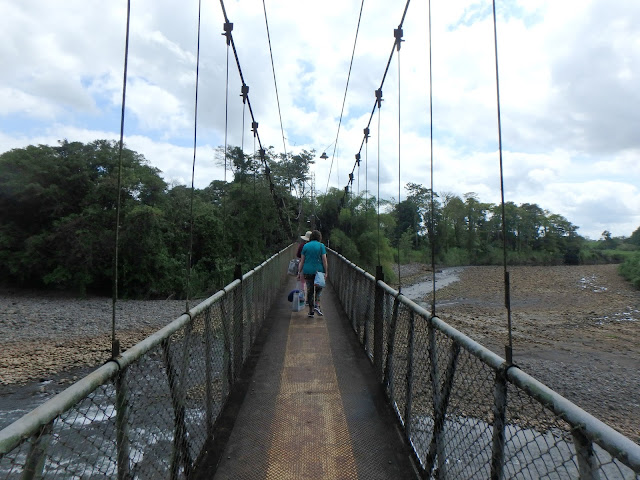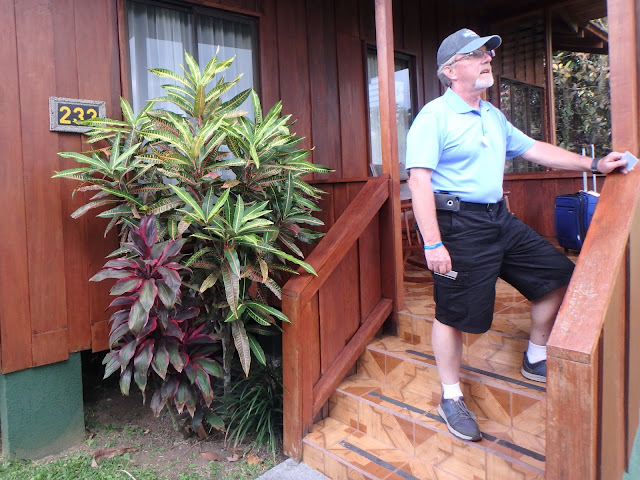DAY 5 Wednesday 4 April 2018
 |
| Joan heading across the bridge |
Back in the 1960's only about 25% of Costa Rica was forested. The government realized the bad path the country was on and started paying people not to cut down trees for farming. They would find out how much the person applying to clear land expected to make off that land and they would pay them that amount to keep the forest intact and encouraged steps to restore the trees. Now >55% of the country is forested and additional conservation efforts are ongoing. 25% of the country is protected as a national park or reserve. Butch had commented to Joan and me that it was too bad they didn't look at Costa Rica as an example to save the Amazon. That was the perfect segue to Don Quintana's comment that they are indeed doing just that! Hopefully, they will be as successful there as Costa Rica has been in saving the rainforest.
He also told us that in 1948, the military was abolished and in 1949 a constitutional article was adopted that banned the military. The money was redirected to education, security, health care and culture. They have about 8,000 active members of the Police Guard forces and that accounts for about 0.4% of the GDP. It is a peaceful country and there has not been a civil war since 1948, unlike other neighboring countries in Central America.
As for education, Costa Rica is a highly educated society as they have made it such a priority. The structure of the school system is:
- 6 years of elementary school
- 6 years of high school
- 4 years of university
Grade school is free and mandatory. Grades 1 - 3 go from 7 - 11:30 and grades 4 - 6 from 12:30 - 4. Most children continue on to high school. Education currently makes up ~7.8% of the GDP. It is supposed to be 8% but even providing 7.8% is quite difficult for the government. Victor used the example of a small town where only 3 or 4 young kids live. They have the right to education, so a school has to be built. There might be only 1 or 2 teachers working at the school and they will have multiple jobs: teacher, principal, cook etc. We saw lots of schools in our travels and the kids all wear uniforms (navy bottoms and white tops) and every school had a football (soccer) field attached.
Don Quintana received a chemical engineering degree in Texas and returned to Costa Rica to work for Coca Cola, eventually retiring from the company as the Director in Central America. He bought a farm where he developed a model dairy that converted manure to electricity to power fans that used water to cool the barns - the beginning of their "eco-farming". I didn't get all the details down on paper, but it sounded something like a swamp cooler here. They eventually were exporting milk and also produced black pepper, cheese, soybeans and corn. They could produce soybeans and corn crops 3 or 4 times/year as they enjoy "eternal spring".
As his children got older and involved in the business, his daughter suggested setting up tours of the eco-farm which were successful. They ultimately sold the original farm and dairy to concentrate on tourism, which is a thriving industry in Costa Rica. They now offer a wide variety of eco-adventure opportunities like zip-lining through the tree canopy, horse rides, rappelling, rafting, floating, hiking and mountain biking. They also operate an organic farm. Don Quintana's son, Alberto Jr., who is now the director of their company, guided us through a portion of the farm. The main crops they export are: pineapples, black pepper and for the first time this year, vanilla.
 |
| Some of their crops on display |
 |
| And some more. I like the yellow ones on the right -- they look like alien spaceships! |
I guess I never knew or thought about where black pepper came from or how it grew. Now I know!
 |
| Black pepper growing on the vine |
Then we heard about the labor intensive process of producing vanilla, the second most expensive spice in the world after saffron. It comes from an orchid, which grows on a vine. There is no natural pollinator for vanilla, so they do it manually with a toothpick, at least at this farm! The flowers are only open for about 4 hours and it is during those hours that pollination must occur. To complicate matters, there are numerous flowers on a stem but only 5 can be pollinated, so you have to keep track of which ones have been pollinated. The gentleman who does the pollination showed us his tools -- a pair of reading glasses and a toothpick!
 |
| Here is an open vanilla flower |
 |
| Here is the vanilla pollen on the tip of a toothpick |
When the beans are ready to pick, they lay them in the sun and turn them every few hours for 28 suns. At that point they are ready to sell or can be saved forever. I can now understand why vanilla is so darned expensive!
One of the other interesting things Alberto showed us was the flower from a carnivorous plant that they are trying to get established as natural protection for their plants. It DID NOT smell good 😝even though it is quite pretty. He cut the stomach thing (for the lack of the right word) open on one of the flowers and there were a bunch of bugs in various stages of being digested.
 |
| Not sure of the species, could be a pitcher plant or a titan |
 |
| The circled thing in this profile view is where the bugs get trapped and digested |
So after seeing many other interesting plants, we had lunch in the eco-friendly hacienda the family built as a retirement project, which is now a lodge where guests can stay. The hacienda was beautiful and the meal, made from organic ingredients they grew, was excellent. Especially yummy was the Star Fruit cheesecake for dessert! During lunch we had the pleasure of meeting Doña Ana Quintana. All of the Quintanas were warm and gracious -- which can be said of all the Costa Ricans we have met so far.
 |
| Living room area of the hacienda |
 |
| Covered patio and surrounding grounds of hacienda |
This is a place I would love to go back to and spend some time. They have the nice lodge where you can stay, but they also have some awesome elevated tents. Check them at this link:
Going Back To Stay In A Luxury Tent -- See Them Here
From Pozo Azul, we headed to La Fortuna de San Carlos. Along the way we passed orchards of oranges. These oranges are yellow on the outside rather than orange and have a strong flavor. Orange juice from this area is exported to Florida. Per Victor, your Florida OJ likely contains some Costa Rican fruit juice! Who knew??
After the wonderful lunch we had, when Victor said we would be stopping for ice cream along the way, I wasn't sure I had room. However, when we arrived at Restaurante Las Iguanas in Muelle, I was off the bus and ready to try the specialty of the house -- Dragon Fruit ice cream. Butch and I had the Dragon Fruit which was purple and sort of tart, but quite good. Joan opted for something safer with some chocolate involved and said hers was good, as well. But the real highlights of the stop were the iguanas that hung out around this restaurant. They were amazing!
 |
| Iguanas hanging out at the restaurant |
There was a tunnel under the busy road in front of the restaurant so they could cross without getting crunched. It was very cool to see them up close.
Here is a video Butch got of the guy above having a little snack on the foliage:
Back on the road again after a very exciting critter encounter, we began to catch glimpses of the Arenal Volcano. Victor said that quite often the top of the volcano is shrouded in clouds but today we have a great view of the entire volcano. Granted, this picture was taken through the window of the moving bus, but I guess it's pretty rare to see the top, so it was a good catch, power lines and all.
 |
| Arenal Volcano |
We stopped in the middle of La Fortuna and had a group picture taken in a beautiful park and then proceeded to our hotel for the night, the Arenal Paraíso Resort & Spa. By the time we arrived, the volcano top was shrouded in clouds and remained that way as long as we were there. We had each had a cabin with a front porch. Ours faced the volcano.
 |
| Butch on our porch looking at the Arenal Volcano |
 |
| Me with volcano in the background, now the top is in the clouds |
 |
| Thermal pools at the resort |
I did a really bonehead thing before we left for the pools. There was a little safe in our room, so I decided we should lock up our wallets and passports since we didn't want to carry that stuff to the pools or leave it unsecured in the cabin. I just assumed that this little safe operated like all the other little hotel safes we have used in the US, so I put the items in, shut the door, put in a 4 digit code and hit the LOCK button. Just to be on the safe side, I entered the code to verify it would open. Guess what -- it didn't!! Then I read the directions that were sitting right next to the safe. There was a little red reset button hidden on the back of the safe door that clears the prior code. You were supposed to press that BEFORE you shut the door and entered your new code. Although I was concerned, I really wanted to get into that hot water, so I figured I would call Reception when we returned or in the morning to get into the safe. Butch, however, couldn't stand the thought of dealing with it in the morning, so while Joan and I finished our soak, he went back to the cabin, called the front desk and someone arrived very quickly with a master key. Apparently, this happens quite frequently and there was no hassle getting them to open the thing up. God bless Butch, he is my hero!
Once back to the cabins, we were all ready for lights out after a long, fun filled day.

Comments
Post a Comment